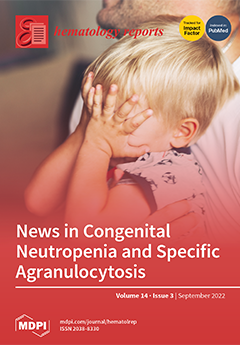The congenital immune system includes neutrophils, which perform a variety of functions. Congenital and acquired neutropenia are rare illnesses with an underestimated prevalence in children. The aim of this study is to examine the epidemiology and etiology of febrile neutropenia in children at
[...] Read more.
The congenital immune system includes neutrophils, which perform a variety of functions. Congenital and acquired neutropenia are rare illnesses with an underestimated prevalence in children. The aim of this study is to examine the epidemiology and etiology of febrile neutropenia in children at Haiphong Children’s Hospital, Haiphong, Vietnam.
Methods: A cross-sectional study was carried out on 421 febrile neutropenia children. Clinical and laboratory characteristics were examined.
Results: The median age (IQR) was 25.0 (12.5–59.5) months. The male-to-female ratio was 1.35/1. There were twice as many children living in the suburbs (66.98%) as in urban areas (33.02%). The mean (SD) temperature at admission was 38.50 ± 0.59 °C. Diagnosed causes associated with neutropenia included acute respiratory infections 250 (59.45%), gastrointestinal infections 68 (16.1%), erythema 37 (8.79%), acute leukemia 15 (3.56%), urinary tract infection 5 (1.19%), and encephalitis/meningitis 4 (0.95%). Viral etiology accounted for 61.52% (259):
influenza type A—50.19% (130),
influenza type B—31.27% (81),
dengue virus—14.67% (38),
measles virus 1—93% (5), rotavirus—1.54% (4), and
EBV—0.4% (1). Twenty-five patients (5.94%) were found to have bacteria in their cultures, with
Streptococcus pneumonia being the most common (eight patients; 32%).
Conclusions: Febrile neutropenia was common in children under 2 years old. Primary clinical manifestations were acute upper respiratory tract infections, and viruses most commonly caused febrile neutropenia. Further studies with larger sample sizes are needed to determine the cause of febrile neutropenia.
Full article






